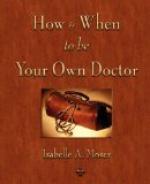Diet For The Chronically Ill.
The chronically ill person has a long-term degenerative condition that is not immediately life threatening. This condition usually causes more-or-less continuous symptoms that are painful, perhaps unsightly, and ultimately will be disabling or eventually capable of causing death. To qualify as “chronic” the symptoms must have been present a minimum of six months, with no relief in sight. People with these conditions have usually sought medical assistance, frequently have had surgery, and have taken and probably are taking numerous prescription drugs.
Some examples of chronic conditions are: arthritis, rheumatism, diabetes, early onset of cancer and aids, asthma, colitis, diverticulitis, irritable bowel syndrome, some mental disorders, arterial deposit diseases, most of the itises (inflammations).
Before fasting, the chronically ill often do have time to prepare the way with limited dietary reform, and frequently begin to feel relief quite quickly. Before actually fasting they should limit their diet to raw foods and eliminate all toxic foods like alcohol, coffee, tea, salt, sugar and recreational drugs for two months if they have been following a typical American diet.
If the chronically ill had been following a vegetarian diet, perhaps a diet including with eggs and dairy, if they had been using no addicting substances, then one month on raw foods is sufficient preparation for fasting. If the person had water or juice fasted for at least a week or two within the last two years, and followed a healthy diet since that time, one or two weeks on raw foods should be a sufficient runway.
During preparation for a fast, I never recommend that a chronically ill person quit taking prescription medicines because doing so can seriously disrupt their homeostasis. However, if their symptoms lessen or vanish during the pre-fasting clean up, the person might try tapering off medications.
The length and type of fast chosen to resolve a chronic illness depends largely on available time, finances, availability of support people, work responsibilities, and mental toughness. If you are one of those fortunate people ‘rich’ enough to give their health first priority, long water fasting is ideal. If on the other hand you can’t afford to stop working, have no one to take care of you and assist with some household chores, and/or you are not mentally tough enough to deal with self-denial, compromise is necessary.
Ideally the chronically ill person would fast for an extended period under supervision until their symptoms were gone or greatly improved, with a fall-back plan to repeat the whole process again in three to six months if necessary. If you are not able to do that, the next best program is to fast for a short period, like one or two weeks, with a plan to repeat the process as often as possible until you are healed.




